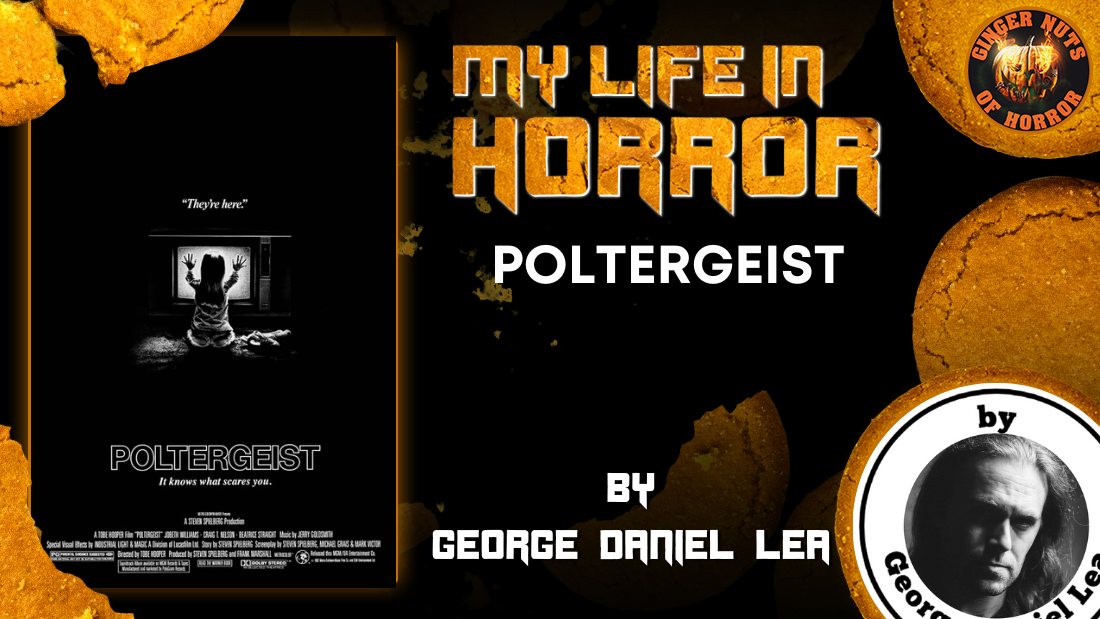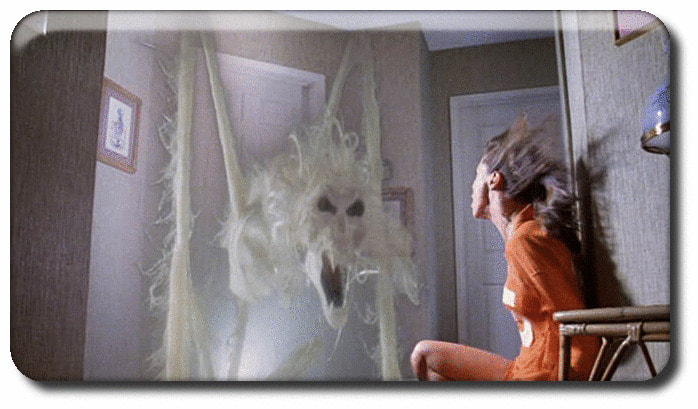My Life In Horror: Poltergeist
5/4/2023
The Freelings, for all the affection the film has for them, are invaders and desecrators in this scenario (albeit unwittingly), as well as victims of the same historical forces. My Life In Horror: Poltergeist I don't clearly recall the first time I saw the original Poltergeist. It's an artefact of childhood, as much so as beloved toys, games and cartoons. I was certainly far too young -by the standards and general assumptions of 1980s British culture-, but that didn't prevent it becoming one of many lynchpins of horror media for me; a standard by which others of similar ilk continue to be measured. The film's imagery, set-pieces, performances and soundtrack are seared into my memory so indelibly that, some 30-odd years later, I can happily replay the film in its entirety behind my eyes. From establishing early scenes, in which we're introduced to the Freeling family; their dynamics and to one another (not to mention the halcyon, 1980s Elysia of Questa Verde), to the metaphysical anarchy that is unleashed later on, this film holds a sentimental charge and significance I find difficult to see past. It's a strange thing, perhaps, to describe examples of horror cinema as comforting, but that's exactly what this is for me; subject matter aside, it evokes -in inchoate and ineffable fashion- a state of being that now only exists in memory; a child that is, ironically, very much a ghost himself. For a work so familiar, it never fails to engage or evoke powerful emotion: From the moment The Star Spangled Banner plays over the opening titles, that first nostalgic chatter of the dead TV channel (younger readers may find that aspect quite mystifying, given that the phenomena simply doesn't exist any more), a sense of old and familiar belonging stirs; a certainty of place and nature that only very young children know. And even the most horrific, dark and disturbing scenes don't discourage that internal smile (if anything, they strain inspire it to spread even further). I feel the weight and texture of a plastic VHS tape in my fingers, remember the whine of the "rewind" function as the tape rolls back. I even recall the electronic smell of o-zone surrounding the old 1980s video player, the heat that radiated from the damn thing when it had been on for too long. But it's so much more than that: it's the texture of old carpets, the smell of no-longer-available washing detergent. It's the unfinished awkwardness of a body and mind that've barely begun to know themselves. In that, the film has grown and evolved as I have; the points of reference and identification shifting and elaborating in response to new contexts. Back then, I distinctly recall identifying strongly with Robbie Freeling, the only boy of the household (also the classic middle-child, who has neither the hysteria of the eldest nor the mystique of youngest daughter, Carol Anne, and therefore struggles to maintain relevance between them). Despite having a number of powerful set-pieces (the invasion of the animated tree, assault by an extremely creepy clown-doll), Robbie plays a tertiary role both in the film and the family (his function is generally to alert the adults of when something unpleasant is manifesting around Carol Anne). Even so, Robbie is a key facilitator of the plot; he's one of the first members of the family to experience fear of his surroundings, to notice -perhaps intuitively- that something is wrong. Likewise, owing to his framing and an amazing performance by actor Oliver Robyns, he is instantly identifiable as a boy-child of the 1980s, ambient details such as the Star Wars toys littering the room he and Carol Anne share, the movie posters on his wall, making him the obvious avatar for those members of the audience who share his demographic. Beyond that, the writing poignantly captures the concerns and sublimated fears of a boy his age in a manner that any child will recognise: For Robbie, as for all of us during our earliest years, the world is a protean state; shadows and doorways seethe with unspoken threat, an approaching storm heralds horrors that no amount of comfort or protection afforded by the middle-class, suburban setting can dispel. The only difference is: For Robbie, those fears have a habit of coming true. Later, revisiting the film after a long absence, it became clear that Robbie's experience is simultaneously gothic and psychological in nature; the former's characteristic concern of "the return of the repressed" runs throughout Poltergeist's mythology (Questa Verde's status as a community created to fulfil corporate concerns, its erection atop ancient burial sites that are treated with utter contempt by the powers of materialism and modernity, are ripe subjects for the American Gothic, even given the film's post-modern nature). Simultaneously, a certain poetry occurs between character and setting: sublimated or repressed fears and concerns are manifested by the supernatural forces at play, Robbie -along with the rest of his family- forced to confront what their entire lives are confections tailored to distract from and deny: The sublimated horrors of history, that are particularly poignant in American horror, given the relative youth of the nation and recency of the atrocities that gave birth to it. And, beyond that: An existential void, that isn't peculiar to any culture or history, but is part of the collective experience of humanity. Poltergeist might not be the first subject matter audiences reach for when it comes to trenchant or poignant commentary. And yet, despite its superficial bravura, its colourful, ghost-train ride aesthetics, there's so much occurring under the razzle-dazzle that we simply weren't equipped to consciously articulate or consider as children: The establishment of Questa Verde as neo-liberal, middle-class idyll is immediate, forceful and deliberate, designed to contrast wildly with the scenes of -seemingly invasive- horror that occur within it. Cleverly, the film does away with the notion that the haunting forces or entities are the invaders, slowly revealing that, rather, they were here long, long before the first shovel-full of earth was turned to lay the synthetic suburbia's foundations. The Freelings, for all the affection the film has for them, are invaders and desecrators in this scenario (albeit unwittingly), as well as victims of the same historical forces. More widely, the film comments upon the lack of sanctity for anything, be it history, family, land or metaphysics, innate to capitalism, which is only too happy to chew up entire landscapes, reduce sites of sanctity to suburban ruin, in the name of quick and easy money. The gothic sensibilities of the "return of the repressed" are made overt here; the apparent "haunting" is a direct symptom of the mutilations property developers have done to the land and the desecrated dead that reside in it. This is made visually overt in the film's closing scenes, when the same interred literally erupt through the grounds of the house, coffins spilling open to display their rot. That the corpses of prior strata of self-proclaimed civilisation burst up through the interiors and grounds of the house is poignantly symbolic; the sham of stability and comfort inherent to delusions of "middle class" status and upward mobility is manifested in the privately-owned property; the domestic castle in which the nuclear family unit is -purportedly- absolute and immovable. This is emphasised by the supernatural phenomena manifesting via the TV; a piece of technology that, in the 1980s, was the very symbol of bourgeois status and also the medium by which capitalist ideology -in all its forms- reinforced itself. The fact that the communications that filter through the dead-air spaces of broadcast impress upon the youngest child first and foremost can be read as a fairly unsubtle stab at the newly unrestricted standards regarding advertising during children's shows and media, that was a point of incredible controversy at the time. The fact that the children -and, in particular, Carol Anne- are the foci for the supernatural set-pieces and often sit at the very heart of the film's horror also rings powerfully in the present day, given that younger generations are slowly waking up to a world that our traditions have poisoned or abandoned to rack and ruin. There is a profound quality in the film of "man handing on misery to man." Whilst the Freelings themselves are happy and loving parents, they are also victims and products of their culture: The film takes pains to paint them as the children of hippies, who've lapsed from their parent's anti-materialist, communal ideals and been swept up in the rampant capitalism of the neo-liberal project (Steven is, at one point, depicted reading a biography of Reagan, even while Dianne rolls a joint in bed). These moments, these resonances, were beyond me -save in the most inchoate, impressionistic fashion- when I was a child, up to the burgeoning of my critical faculties, when I began to read films as texts and appreciate their import beyond the purely aesthetic. Watching it now, some thirty years later, I'm struck speechless by the variety of levels on which it operates, from the aforementioned ghost-train ride aesthetic to the Hitchcock's Half Hour, beyond-the-picket-fences social and political commentary. As is the nature of media, it has grown and evolved as I have, morphing into different and more elaborate states in sympathy with the mind that experiences it. Whilst that old sentiment will always be there -and always happily indulged-, it's a joy to find that complemented and contrasted now by a whole suite of new layers and potentials, all of which serve to make it, arguably, one of my most abiding favourites from the hazy, barely-recalled dream-lands of early childhood. check out today's book review belowHOME the heart and soul of horror promotion websites
0 Comments
|
Archives
April 2023
|






 RSS Feed
RSS Feed

